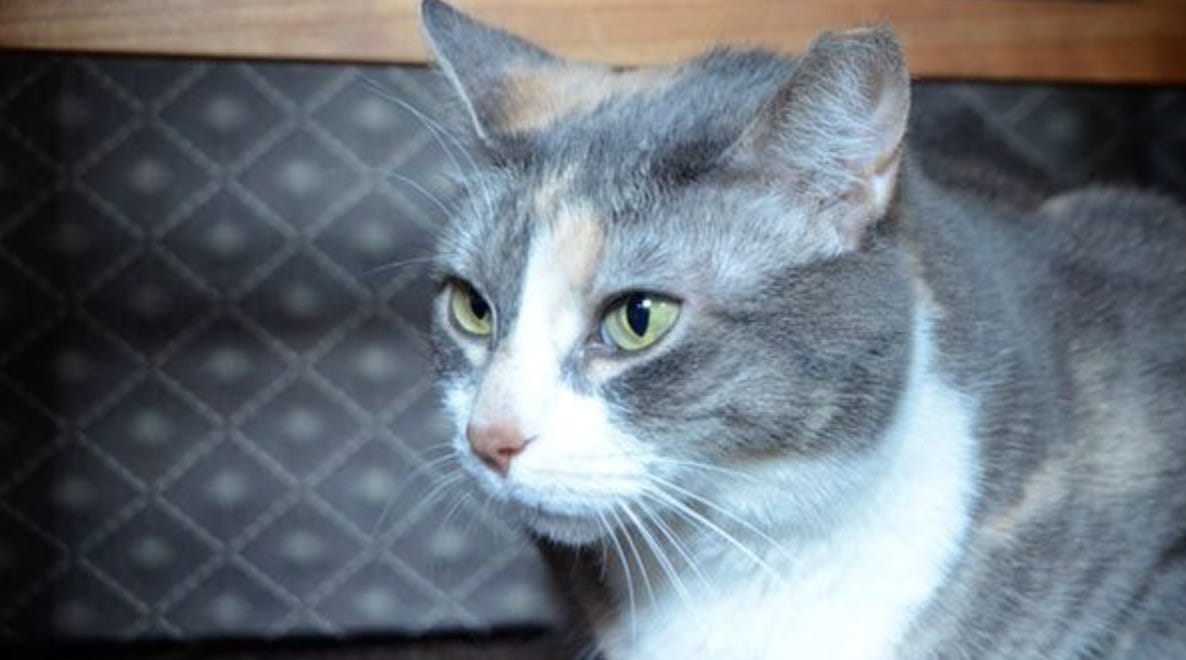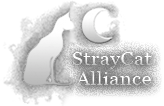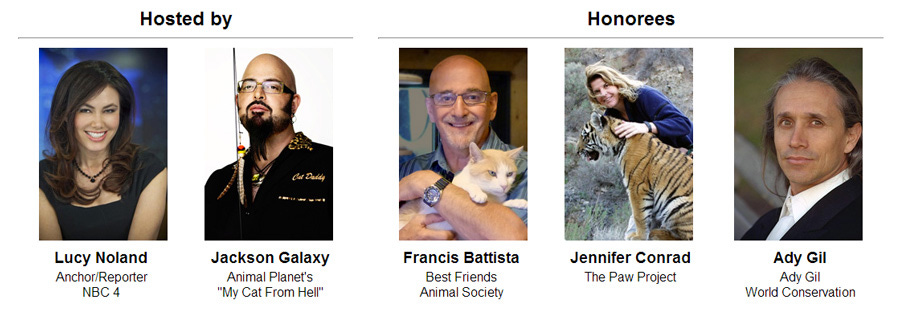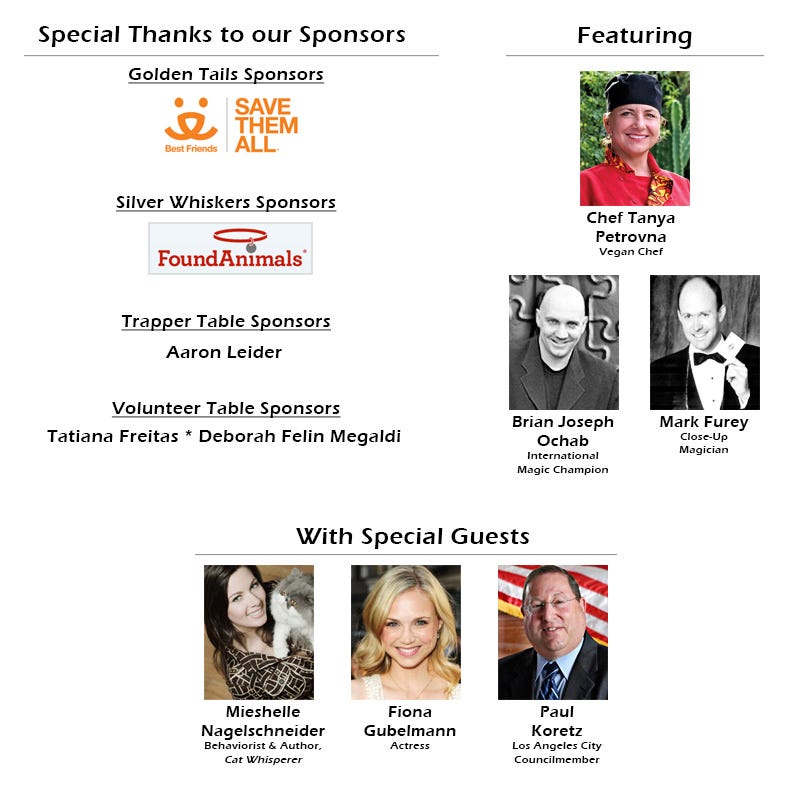It's a ‘Purrfect’ Match!
Mieshelle Nagelschneider (AKA The Cat Whisperer) & Jackson Galaxy Join Forces in Support of Stray Cat Alliance
By Jordan Schaul | National Geographic | October 1, 2013 (Updated)
This past summer, NBCLA’s Lucy Noland shared some positive news concerning the stray cat crisis facing Los Angeles and other metropolitan cities. Out-of-control stray populations have become a hazard to native birds and small mammals and can transmit diseases to wild cat species like bobcats and mountain lions.
I specifically mention “stray” and not “feral“ cat populations, as the worrisome feline demographic seems to be comprised of strays, according to the LA-based cat rescue and advocacy organization, Stray Cat Alliance.
This distinction, as made by the national cat advocacy organization Alley Cat Allies, is important because stray cats, like “resident” cats in the home, are socialized to people and can be acclimated or reconditioned to life inside where they can once again thrive as companion animals.
By helping to reduce the overpopulation of stray cats through owner and would-be owner education and more directly by neutering (removing reproductive organs of either gender) adult and sub-adult cats, Stray Cat Alliance is mitigating problems posed by these pets.
Stray Cat Alliance not only thwarts recruitment of strays into feral populations, but it provides permanent and foster homes for strays. Ferals are more challenging to deal with but humane intervention can prevent the birth of the unwanted litter.
The organization works anywhere there is a need, including low-income neighborhoods, which may require the most attention. In these areas, clientele and other residents may be entirely unaware or, at least, incapable of employing responsible measures to care for an already overwhelming number of domestic cats out “on the prowl.”
Christi Metropole, the Executive Director of the Stray Cat Alliance said, “In two years we have neutered over 5000 cats in its effort to help Los Angeles become a “no-kill” city.
But she and her staff and hundreds of volunteers have more ambitious plans. They hope to not only build a “no-kill” city but become a model for other metropolitan areas in hope of building a “no-kill” nation. They are working to help LA one stray at a time. And for a city as large a size as Los Angeles, the stray population is a big problem.
The most responsible thing a cat owner can do is keep his or her cat indoors, and certainly make sure they are spayed or neutered and vaccinated.
Animal advocacy groups like the Stray Cat Alliance are ardent supporters of Trap, Neuter, and Return (TNR). This method of population control is considered humane and supports the “no-kill” agenda of Stray Cat Alliance and complements the organization’s rescue efforts.
Some wildlife conservationists argue that TNR programs have limitations as a measure for controlling stray and feral cat populations. They are concerned that the practice may not adequately address issues more peripherally in relation to population control. For example, conservationists worry about the impact free-roaming domestic cats have on veterinary public health and human health in terms of communicable disease transmission, or their impact on wildlife populations.
Disciples of activist and lawyer Nathan Winograd, like Ms. Metropole, are true and ardent supporters of Trap, Neuter, and Release (TNR) programs.
“For every dollar, you spend on spay or neutering cats, you save $10 that you would spend on warehousing, killing, and disposing of that animal”. - Christi Metropole, Executive Director of Stray Cat Alliance
A recent study suggests that vasectomized or hysterectomized (TVHR) cat populations are even less sustainable or easier to extinguish than TNR populations. In fact, in a blog post summarizing the study, Nat Geo News staff writer Christine Dell’Amore reported the following:
“The results showed that if 35 percent of a cat population underwent TVHR, that population would be reduced by half and would disappear in 11 years. Alternatively, if the cat population underwent TNR, 82 percent of cats would need to be captured and neutered in order to eliminate the colony in 11 years.”
Albeit promising news, the American Veterinary Medical Association’s Animal Welfare Division said, “It’s unlikely a single tactic will be a cure-all for the feral-cat problem.”
Black Cat Rescue in Boston, like Stray Cat Alliance in Los Angeles, is praised by cat enthusiasts. Similar to Stray Cat Alliance, Blac Rescue finds homes for otherwise unwanted animals and makes critical contributions to cats in need of homes and capable of being helped.
Black cats, in particular, have suffered greatly for centuries at the hands of humans. They have been abused and tortured. Black cats continue to be abused due to the persistence of pure mythology, but all cats suffer when their human caretakers act irresponsibly.
This month, Stray Cat Alliance will celebrate its annual event and the 13th Anniversary of the Stray Cat Club on the evening of October 19th.
Special guests will include internationally renowned cat behaviorists Mieshelle Nagelschneider and Jackson Galaxy of Animal Planet’s My Cat From Hell.
In my back cover review for Mieshelle’s scholarly-cited book The Cat Whisperer (co-authored with Cameron Powell), I shared the following commentary:
“The reason people are so mesmerized by house cats is that they are truly miniature versions of lions, tigers, and leopards. Mieshelle explains in an unprecedented and a most accessible way, the behavior of the house cat, with her unique insight into the often misunderstood companion animal that is as wild as we have become civilized.” -Jordan Carlton Schaul
I look forward to meeting Jackson Galaxy (AKA Cat Daddy) and picking his brain for some ‘insider’ cat knowledge. The Stray Cat Alliance would also like to thank the sponsors of the event and special guests.
For more information on cats, please check out National Geographic Society’s new mini-blog Cat Watch!
ABOUT NATIONAL GEOGRAPHIC SOCIETY
The National Geographic Society is a global nonprofit organization that uses the power of science, exploration, education and storytelling to illuminate and protect the wonder of our world. Since 1888, National Geographic has pushed the boundaries of exploration, investing in bold people and transformative ideas, providing more than 14,000 grants for work across all seven continents, reaching 3 million students each year through education offerings, and engaging audiences around the globe through signature experiences, stories and content. To learn more, visit www.nationalgeographic.org or follow us on Instagram, Twitter and Facebook.
MEET THE AUTHOR
Jordan Carlton SchaulWith training in wildlife ecology, conservation medicine, and comparative psychology, Dr. Schaul's contributions to Nat Geo Voices have covered a range of environmental and social topics. He draws particular attention to the plight of imperiled species highlighting issues at the juncture or nexus of sorta situ wildlife conservation and applied animal welfare. Sorta situ conservation practices are comprised of scientific management and stewardship of animal populations ex situ (in captivity / 'in human care') and in situ (free-ranging / 'in nature'). He also has a background in behavior management and training of companion animals and captive wildlife, as well as conservation marketing and digital publicity. Jordan has shared interviews with colleagues and public figures, as well as editorial news content. In addition, he has posted narratives describing his own work, which include the following examples: • Restoration of wood bison to the Interior of Alaska while (While Animal Curator at Alaska Wildlife Conservation Center and courtesy professor at the University of Alaska) • Rehabilitation of orphaned sloth bears exploited for tourists in South Asia (While executive consultant 'in-residence' at the Agra Bear Rescue Center managed by Wildlife SOS) • Censusing small wild cat (e.g. ocelot and margay) populations in the montane cloud forests of Costa Rica for popular publications with 'The Cat Whisperer' Mieshelle Nagelschneider • Evaluating the impact of ecotourism on marine mammal population stability and welfare off the coast of Mexico's Sea of Cortez (With Boston University's marine science program) Jordan was a director on boards of non-profit wildlife conservation organizations serving nations in Africa, North and South America and Southeast Asia. He is also a consultant to a human-wildlife conflict mitigation organization in the Pacific Northwest. Following animal curatorships in Alaska and California, he served as a charter board member of a zoo advocacy and outreach organization and later as its executive director. Jordan was a member of the Communication and Education Commission of the International Union for the Conservation of Nature (CEC-IUCN) and the Bear Specialist Group of the IUCN Species Survival Commission (BSG-SSC-IUCN). He has served on the advisory council of the National Wildlife Humane Society and in service to the Bear Taxon Advisory Group of the Association of Zoos and Aquariums (AZA Bear TAG). In addition, he was an ex officio member of the council of the International Association for Bear Research and Management.








